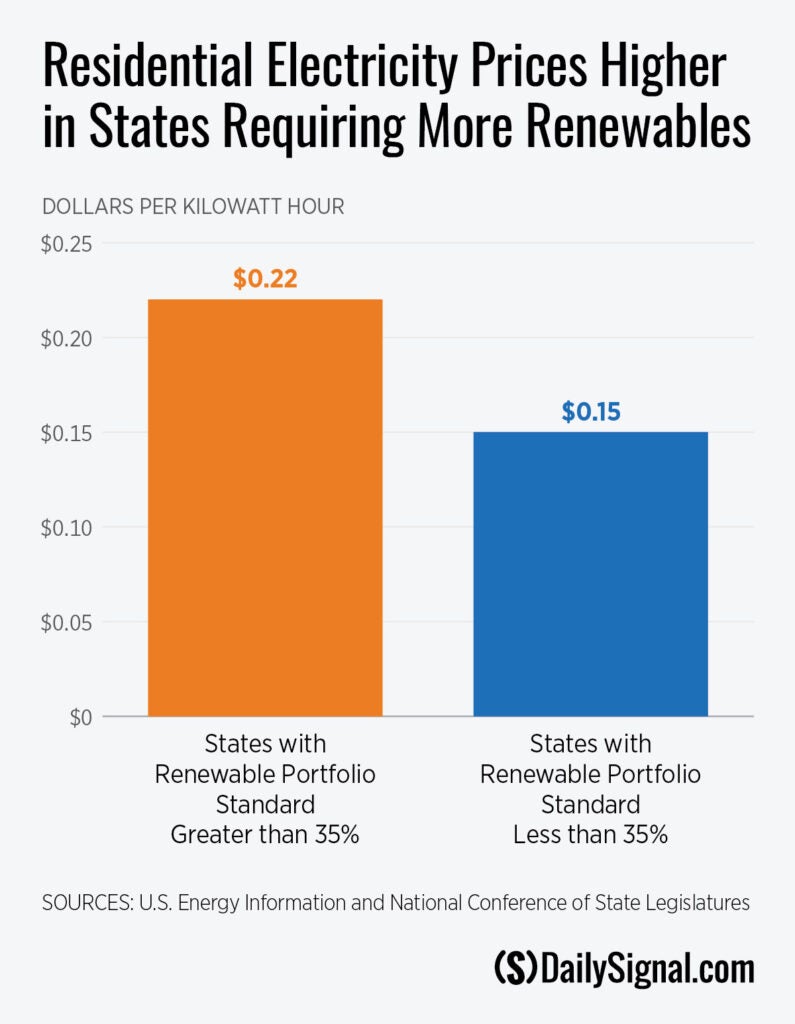Electricity Affordability, Reliability at Stake With ‘Green Energy’ Push
Andrew Weiss /
Imagine that you are faced with a choice: Keep using a reliable source of energy or switch to one that produces 2% as much and only operates for 10 hours at a time. Remember that you’ve got to keep your lights and computer on, your smartphone charged, and the food in your fridge and freezer fresh. Not to mention keeping your shower water hot, the temperature in your home comfortable—and you certainly don’t have time to wash your dishes or your clothes by hand each day.
So, which energy source do you choose?
If you live in Wisconsin and green energy groups Power Wisconsin Forward and Clean Economy Coalition of Wisconsin get to choose, it will be the latter.
The Columbia Energy Center, Wisconsin’s largest coal plant, produces nearly 10% of the state’s electricity. With the help of $31 million in federal grants, the plant will be shut down and replaced by a “green energy” storage dome whose power output will be a mere 2% of the coal plant’s output. The energy dome only functions for 10 hours before needing to shut down and recharge.
Craig Ervin, a welder from Eau Claire, is baffled by these changes. “These green energy projects are a dumb investment for Wisconsin,” he states bluntly. “It won’t benefit anyone, and it’ll just be a big money pit.” And he’s right.
Wisconsin’s Public Service Commission is being pressured by green energy advocates to deny utility companies from expanding natural gas power plants—intended to replace coal-fired plants that are being prematurely shut down in Sheboygan and Oak Creek.
For those concerned about carbon emissions, transitioning from coal to natural gas is preferable because gas plants emit half as much carbon as coal for the same amount of energy produced.
But that’s not good enough for the green energy groups. In the name of climate change, these advocates are acting to prevent natural gas from replacing the coal plants.
Instead of natural gas, the green energy advocates propose rooftop solar panels and large-scale wind and solar power. If Ervin relies on rooftop solar, he will have to spend a lot of time shoveling snow off his roof, because last year, Eau Claire saw 116 consecutive days of snow cover.
Snow isn’t the only problem with solar power. Solar and wind energy’s variability in output leads to grid instability and higher electricity costs.
Since power generation from solar and wind is not predictable, with output plummeting when a cloud blows in or when the breeze suddenly stops, other power sources must rapidly ramp up production to prevent blackouts. This unpredictable cycle forces traditional hydrocarbon-based (coal, oil, and natural gas) power plants to operate below full capacity much of the time. Running at reduced efficiency means traditional power plants must charge higher prices to remain economically viable.
Green groups blame power companies for raising electricity prices, but that’s like blaming grocery stores for high food prices when they’re just recouping the higher prices they had to pay suppliers because of inflation that government spending caused.
Residential electricity prices in the Midwest have surged almost 30% over the past four years.
The real reason for higher electricity prices is simple. States that require more than 35% renewable energy by 2035 face 47% higher energy costs than states that don’t have these requirements, known as renewable portfolio standards.

Contrary to what green advocates may claim, the use of renewables will hardly affect global temperatures. While America has cut its carbon emissions by 18% in the last 15 years (largely by transitioning from coal to natural gas), China has increased its carbon emissions by 91% and now produces three times more than the U.S.
According to U.S. government climate models, even if the United States stopped burning all hydrocarbons right now, the effect on global temperatures would be less than 0.2 degrees Celsius by the year 2100, compared to current projections.
An authentic environmentalist should not act single-mindedly against carbon dioxide emissions, which are not toxic (and are, in fact, necessary) to humans, plants, and animals. Of the harmful pollutants such as lead, nitrogen oxides, and sulfur dioxide, America has reduced their emissions by 99%, 75%, and 94%, respectively, since 1980.
Green energy subsidies are wolves in sheep’s clothing; while they may seem to promote progress, they ignore local decision making, increase costs, and reduce energy reliability.
Wisconsin can use affordable fuels for electricity or allow a few green energy advocates to dictate the energy mix, resulting in higher costs and instability. Wisconsinites, like most Americans, surely prefer lower costs and knowing that electricity will be there to reliably power their computers, fridges, and phones.
